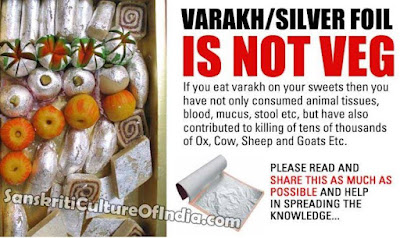Varakh/Silver Foil is NOT VEGETARIAN
Did you lend second thoughts to the ultra-thin layer of silver that covers your sweets or paan? Maybe not! However, this ultra-thin layer of silver, or 'varakhâ' as it is known, should not be taken for granted. Investigations by organizations such as Beauty Without Cruelty (BWC) and the Food and Drug Administration (FDA) of India have revealed that the bulk of the varakh available in the country is non-vegan and non-vegetarian besides containing harmful metals that are carcinogenic in nature.
What makes the varakh non-vegan and non-vegetarian?
If you look beyond the glitter of varakh, into the sheds where it is produced, and at the lives that are sacrificed to make this possible, you would think twice before buying that box of sweets topped with the precious silver foil!
Silver foil, or varakh, as it is generally known in India, adds glitter to Indian sweets (mithai), supari (betel nut), paan (betel leaf), and fruits. Also, it is used in Ayurvedic medicines and on deities in many Jain temples. The silver-topped sweet is even served as prasad in temples and on auspicious and religious occasions. Varakh is also used in flavored syrups as in kesar (saffron) syrup.
Several years ago, as suggested by BWC, Indian Airlines instructed their caterers to stop the use of varakh on sweets (mithai) served on board their flights. Today, many ask for sweets without varakh, having realized the cruelty involved in their preparation.
According to a feature article in Business India, an astounding 275 tons of silver are eaten annually into foil for sweets and chyavanprash! That is a whopping 2,75,000 kilograms! (At the present market rate that would cost a phenomenal Rs. 165 Crore or $ 40 million U.S. Dollars). /*Just how is varakh made and what is it that makes its preparation and consumption so sinful?
What makes the varakh non-vegan and non-vegetarian?
If you look beyond the glitter of varakh, into the sheds where it is produced, and at the lives that are sacrificed to make this possible, you would think twice before buying that box of sweets topped with the precious silver foil!
Silver foil, or varakh, as it is generally known in India, adds glitter to Indian sweets (mithai), supari (betel nut), paan (betel leaf), and fruits. Also, it is used in Ayurvedic medicines and on deities in many Jain temples. The silver-topped sweet is even served as prasad in temples and on auspicious and religious occasions. Varakh is also used in flavored syrups as in kesar (saffron) syrup.
Several years ago, as suggested by BWC, Indian Airlines instructed their caterers to stop the use of varakh on sweets (mithai) served on board their flights. Today, many ask for sweets without varakh, having realized the cruelty involved in their preparation.
According to a feature article in Business India, an astounding 275 tons of silver are eaten annually into foil for sweets and chyavanprash! That is a whopping 2,75,000 kilograms! (At the present market rate that would cost a phenomenal Rs. 165 Crore or $ 40 million U.S. Dollars). /*Just how is varakh made and what is it that makes its preparation and consumption so sinful?



Comments
Post a Comment